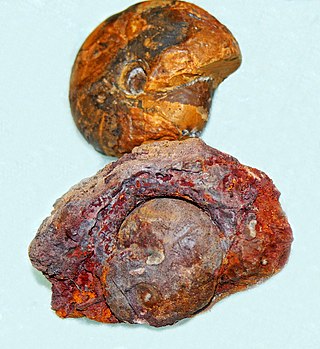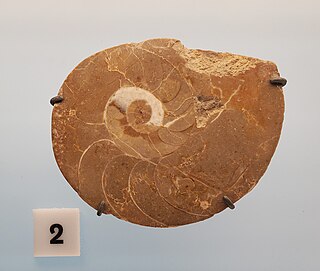Beyrichoceras is a genus belonging to the goniatitid family Muensteroceratidae, a group of ammonoids, extinct shelled cephalopods related to belemnites and recent coleoids and more distantly to the nautiloids

Beyrichoceras is a genus belonging to the goniatitid family Maxigoniatitidae that lived during the Mississippian Period
Uraloceras is an ammonoid cephalopod genus belonging to the goniatitid family Paragastrioceratidae. The genus was named by Ruzhencev 1936 and is a jr. synonym of Pseudogastrioceras Spath 1930 according to Miller, Furnish and Schindeworlf, 1957. More recent classifications however list the two as distinct genera and put Uraloceras in the Paragastrioceratinae and Pseudogastrioceras in the Pseudogastrioceratinae.
Cheiloceratidae is a family of ammonoid cephalopods included in the goniatitid suborder Tornoceratina in which the suture has 4 to 12 lobes, the ventral one undivided and those in the lateral areas originating as subdivisions of internal and external lateral saddles.
Tornoceratoidea, also known as Tornocerataceae, is a superfamily of goniatitid ammonoids included in the suborder Tornoceratina. Tornoceratoidea, or Tornocerataceae, is essentially the Cheilocerataceae of Miller, Furnish, and Schindewolf (1957) in the Treatise Part L, revised to accommodate new taxa and new perspectives on the phylogeny.
Tornoceratidae is a family of goniatitid ammonoids from the middle and upper Devonian. The family is included in the suborder Tornoceratina and the superfamily Tornoceratoidea.

Goniatitoidea, formerly Goniatitaceae in older publications, is a superfamily of late Paleozoic ammonoid cephalopods included in the Goniatitida. They are characterized by thinly discoidal to globular shells with variable umbilici and sculpture. The ventral lobe, located along the outer margin, is prominently bifurcated ; the lateral lobe undivided.
Texoceras is an extinct ammonoid genus in the monotypic goniatitid subfamily Texoceratinae, included in the family Adrianitidae. These were shelled cephalopods more closely related to squids, belemnites, octopuses, and cuttlefish than to nautiloids from which they are derived.

Goniatitinae is one of six subfamilies into which the Goniatitidae is subdivided according to Miller, Furnish, and Schindewolf, 1957. The diagnostic character is the narrow bifurcated ventral lobe of the suture, which lies along the outer rim. As with the inclusive Goniatitidae, sutures have eight lobes, shells are without prominent ornament, umbilici are small to moderate in size.
Thalassoceratidae a family of late Paleozoic ammonites included in the goniatitid superfamily Thalassoceratoidea along with the Bisatoceratidae. Some eight genera are included, although the specific number and exactly which depends on the particular classification.

Medlicottiidae is a family of ammonoid cephalopods belonging to the Prolecanitida, known from the Upper Carboniferous (Pennsylvanian) to the Early Triassic.

Prolecanitida is an order of extinct ammonoid cephalopods, the major Late Paleozoic group of ammonoids alongside the order Goniatitida. Prolecanitids had narrow shells, discoidal (disc-shaped) to thinly lenticular (lens-shaped). They retained a retrochoanitic siphuncle, a simple form with septal necks extending backwards. As is typical for ammonoids, the siphuncle sits along the ventral margin of the shell.

Clyclolobus is a smooth, essentially involute subdiscoidal goniatitid ammonoid that has sutures with a bifurcate ventral lobe, flared outwardly at the end, in which the halves may be secondarily trifurcated, ending in sharp, narrow projections. Lateral sutural elements follow an acuate line that swings first to the front, then sharply to the rear before becoming hidden by the next whorl. Saddles are narrow, cumulous in appearance with short, irregular, rounded sub-endings. Ventro-lateal lobes are trifurcate with pointed, thorn-like projections.

Mimagoniatites is a genus of ammonoid cephalopod which lived during the early Devonian, regarded as belonging to the Agoniatitdae as a member of the subfamily Mimagoniatitinae.

Clymeniida is an order of ammonoid cephalopods from the Upper Devonian characterized by having an unusual dorsal siphuncle. They measured about 4 cm (1.6 in) in diameter and are most common in Europe, North Africa, and South China but are known from North America and Australia as well.
Karagandoceratoidea is an Early Carboniferous (Mississippian) superfamily within the ammonoid order, Goniatitida, said to contain the Karagandoceratidae and Prodromitidae.
Pachylyroceras is a large, generally subglobular, Upper Mississippian gonitite and included in the cephalopod subclass Ammonoidea.
Cravevoceras is an Upper Paleozoic ammonite in the goniatite family Cravenoceratidae, probably derived from Pachylyroceras and contemporary with other cravenoceratid genera like Caenolyroceras, Tympanoceras and later Alaoceras and Lyrogoniatites. It is also a member of the Neoglyphioceratoidea.
The Uddenitinae a subfamily of the Medlicottiidae, a family of ammonoid cephalopods included in the Prolecanitida. The Uddenitinae, proposed by Miller and Furnish, and known from the Pennsylvanian and Lower Permian, are transitional between the ancestral Pronoritidae and the more traditional medlicottiids.
Neoglaphyrites is a goniatitid ammonite that lived during the latest Pennsylvanian and early Permian. Its shell is ellipsoidal and moderately involute; the umbilicus deep and typically less than 15 per cent of the shell diameter but in some species closer to 20 per cent. Delicate growth lines forming ventral and lateral sinuses and ventrolateral and dorsolateral salients have been found on Canadian Arctic specimens. The suture is characterized by the ventral lobe split into two broad prongs that are separated by a high median ventral saddle; prongs closely approximate the width of the first lateral lobe. The first lateral saddle is evenly rounded and is nearly symmetrical. The umbilical lobe is V-shaped and internal lobes are deep and narrow.






